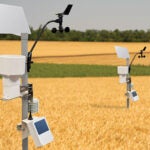- Resources
- Two things to do now to avoid supply chain disruption later
Resources
Two things to do now to avoid supply chain disruption later
Published: June 15, 2020 by Jenny Ahlen
The COVID-19 pandemic has lifted the veil off of supply chains and shown that they aren’t soulless assembly lines of automatons that move things from here to there. They’re complex, connected and powered by people, and for every product shortage or plant closure caused by disruption to the supply chain, there are hundreds or thousands of workers whose livelihoods — and often their health — are at immediate risk. Plus, trillions lost in global revenue.
Unfortunately, pandemics aren’t the only risk to supply chains. Multiple external factors can disrupt business-as-usual, with climate change at the top of the list. Higher temperatures, increased drought, more frequent natural disasters, rising seas and shifting crop yields have already been impacting businesses across the globe.

These real-world climate change impacts are exposing vulnerability across business operations and their suppliers, forcing companies to evaluate and rethink the resilience of their supply chains.
Here’s how business leaders can start future-proofing their supply chains today.
Know your supply chain
Supply chain visibility is key, because without it, companies can’t anticipate future disruptions and plan accordingly.
Among the simplest things business leaders can do to better understand their impact and risk is to fully map their supply chains and assess each link’s risk, sustainability and resilience. The more visibility into each suppliers’ operations and vulnerabilities, the better.
Moreover, the better a company knows each piece of its supply chain, the more it can require and incent commitments and performance that not only increase overall resilience, but align with the company’s broader social and environmental goals, and growing consumer and employee expectations.
Innovate to build resilience
Technology has led to remarkable advancements in supply chain management. Scanning and tracking systems provide companies unprecedented insight into their operations and the movement of raw materials and products around world. Algorithms allow companies to glean minute cost- or time-saving insights when their inventory is digitized.
But here, again, it’s important to point out the prevalence of cost and efficiency as the driver for better technology. Investments in better data and technology can also help companies design and operate more sustainable and resilient supply chains. Leaders have the opportunity to use new smart supply chain tools and data to incent and reward suppliers that are improving environmental performance and reducing risk.
McDonald’s, for example, is working with ag-tech companies to track the origin of all Brazilian beef supplied to its restaurants, using satellite imagery and data analysis to determine whether deforestation occurred at the farm level and implement improvement plans when needed.
Rebuild better together
CDP recently reported a 24% increase in companies asking for greater transparency from their suppliers. Perhaps more encouraging is that new members joined the organization’s supplier program in March and April, after it was clear that the pandemic would spark unprecedented financial pressure for the foreseeable future. Companies could use COVID-19 as cover to backtrack on sustainability leadership. But CDP’s survey suggests that its members are even more committed to the long-term value of building sustainability and resilience into their companies’ supply lines.
That sentiment must continue and accelerate. Because though we hope we’ll never face another global disruption like the one we’re living through now, we know that a changing climate will put new pressures on suppliers and manufacturers around the world. And the uncertainty of what lies ahead only builds further urgency around the need for more resilient supply chains.
Companies can learn from this year’s unprecedented disruption and commit to improve. To recognize vulnerabilities and better protect their companies, employees and customers from future impacts. Because resilience is no longer a nice to have — it’s a must have.

